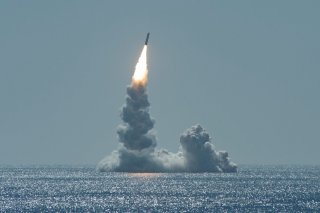Should U.S. Navy Submarines Carry Low-Yield Nuclear Weapons?
A debate is raging about whether they would make nuclear war more or less likely.
Here's What You Need to Remember: “If you have a sea launched nuclear cruise missile, it can change an enemy’s thought process. If they escalate, but know we have something in kind, they have to ask themselves ‘do we really want to do that’?”
Would arming U.S. Navy submarines with a low-yield, nuclear missile lower the threshold to a potential nuclear weapons conflict, making it more likely? Some say yes, others say no. The debate still rages.
The 2018 Nuclear Posture Review calls for the addition of such a weapon, which senior Pentagon leaders say is now taking steps forward in its development. The thinking with the new weapon, to be joined by a low-yield variant of the Trident II D5 which has already been built, would offer a tactical nuclear weapon option to commanders. The theory is that a smaller nuclear weapon would be a way to reinforce, strengthen and fortify a deterrent posture, thereby actually reducing the prospect of an actual nuclear encounter. Several years ago, former Defense Secretary Jim Mattis said part of the rationale for the new weapon was to bring Russia back to the negotiating table, following its violation of the Intermediate Range Forces (INF) Treaty and its construction of tactical nuclear weapons.
Those expressing concern about the weapon, which includes some voices in Congress, make the argument that a tactical nuclear weapon of any kind might instead send a message that some kind of limited nuclear weapons attack might be feasible. Such a strategic consciousness, the thinking extends, therefore may make the actual use of such a nuclear weapon realistic and upend the basic premise of strategic deterrence. This would be bad since strategic deterrence maintains that the entire existence of nuclear weapons rests upon a paradox: possess overwhelming destructive power so as to ensure it never has to be used, thus meaning the existence of nuclear weapons, ironically, keeps the peace. The essence of deterrence. Would deploying a sea-launched tactical nuclear cruise missile actually undermine deterrence and make peace more fragile? Perhaps tactical nuclear weapons would make peace more susceptible to an explosive and unforeseen disruption?
Advocates for the weapon, such as Vice Adm. Johnny Wolfe, Director of the U.S. Navy’s Strategic Systems Program, say no. He argues that nuclear cruise missiles would conversely greatly strengthen deterrence. Wolfe further elaborated upon this thinking by referring to Russia’s well known “escalate to de-escalate” posture, saying Russia’s use of this kind of approach would be to threaten the use of a tactical nuclear weapon to “back us down.”
“If you have a sea launched nuclear cruise missile, it can change an enemy’s thought process. If they escalate, but know we have something in kind, they have to ask themselves ‘do we really want to do that’? This puts the threshold right where it needs to be so nobody thinks using nuclear weapons can provide any advantage,” Wolfe told The Mitchell Institute for Aerospace Studies.
Kris Osborn is the defense editor for the National Interest. Osborn previously served at the Pentagon as a Highly Qualified Expert with the Office of the Assistant Secretary of the Army—Acquisition, Logistics & Technology. Osborn has also worked as an anchor and on-air military specialist at national TV networks. He has appeared as a guest military expert on Fox News, MSNBC, The Military Channel, and The History Channel. He also has a Master's Degree in Comparative Literature from Columbia University. This article first appeared earlier this year.
Image: Flickr.

